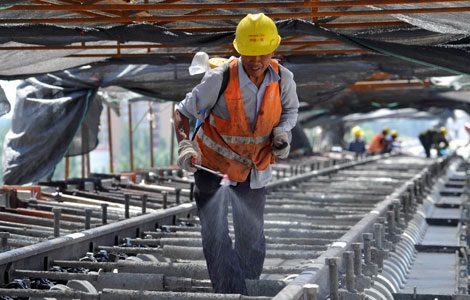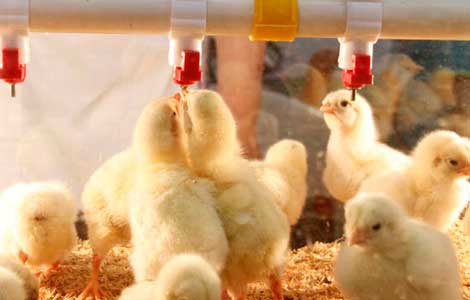Growth hangs in the balance
Updated: 2013-07-18 08:17
By Zhang Ming (China Daily)
|
||||||||
While stabilizing GDP, the authorities must continue to push forward restructuring amid economic difficulties
The growth of China's gross domestic product slowed to 7.5 percent year-on-year in the second quarter, down from 7.7 percent in the previous quarter. This was the fifth consecutive quarter of growth below 8 percent, a clear sign of an economic downturn in the world's second-largest economy. The growth momentum of consumption, investment and exports, the three main drivers of China's economic growth, has weakened, and it could be difficult to realize the 7.5 percent annual growth target set for the year.
The prospects for exports are particularly gloomy due to a lingering slump in external demand and a fast rise in the yuan's effective exchange rate in the first half of this year. The country's exports are expected to further weaken in the months ahead.
The outlook for investment is also rather gloomy. Overproduction looms large in the context of the feeble external demand, and the weak investment willingness among domestic manufacturers and ongoing de-stocking efforts have restricted China's capability for further investment. Real estate investment, which has long had the lion's share of the country's fixed asset investment, has decelerated due to the funds crunch experienced by developers as the result of the government regulations to cool the housing market. At the same time, high debts and reduced financing channels and strengthened government efforts to regulate shadow banking, a major source of funds for local governments, have further weakened local governments' capability to expand their infrastructure investment.
With the deceleration in exports and investment, consumption has been a stable contributor to China's economic growth. However, a decline in the growth of incomes since the end of last year and a worsening labor market will curb what was robust growth in consumption.
The central government has made unremitting efforts to push for structural reforms over the past months demonstrating an increased tolerance for an economic slowdown. These reforms, which are non-stimulus, deleveraging and structural adjustments, are indispensable if China is to develop into a healthy economy.
However, if the national economy continues to slow, there will be growing pressures for decision-makers to take measures to stabilize growth instead of continuing to promote structural adjustments, as reflected by Premier Li Keqiang's remark during his recent tour of the Guangxi Zhuang autonomous region, that the country will strive to maintain the "lower target of growth".
But despite a possible policy shift to stabilize growth, the government will heed the lessons from the large-scale stimulus programs adopted in the wake of the global financial crisis in 2009 and not introduce similar stimulus measures. Instead, slight macroeconomic policy adjustments can be expected in the second half of the year.
The stable and controllable inflation, so far, leaves lots of room for China's central bank to moderately adjust its monetary policies. The negative growth in the country's funds outstanding for foreign exchange in June make it unavoidable that the central bank will choose to reverse repurchases as a kind of monetary policy adjustment. The monetary authorities will likely lower the deposit reserves to increase liquidity into the market in the latter half of this year, a move that will make impossible a "cash shortage" like the one the market experienced in June. But there is only a slim possibility of interest rate cuts.
Adopting a prudent fiscal policy will allow the central government to spend more on constructing urban facilities and low-income housing, industries of strategic significance, energy conservation and environmental protection.
With the growth in exports continuing to slow, the central bank is expected to put an end to the yuan's robust appreciation against the dollar and to take measures to stabilize it or moderately depreciate it. Such a policy change will help ease the rise of the yuan's effective exchange rate at a time of a strengthening dollar. But, considering the lag before exchange rate changes have an effect on exports, China's exports will still pay the price in the latter half of this year for the fast rise in the yuan's value.
Considering the limited room for investment growth in manufacturing and infrastructure construction, the government is expected to loosen some of the real estate regulations, especially relaxing credit controls on first homes. At the same time, the plan for the implementation of a nationwide property tax will likely be further postponed.
If China proceeds with these policy changes, the country is expected to realize a 7.3 percent to 7.5 percent full-year GDP growth at least, a speed that will help its economy realize a soft landing.
But while trying to stabilize growth, the government should not forget the need for structural adjustments, given that its old extensive growth model cannot be maintained. Without a successful shift in its economic growth model, within three to five years China will either experience a systematic financial crisis or the middle income trap.
The author is a researcher with the Institute of World Economics and Politics under the Chinese Academy of Social Sciences.
(China Daily 07/18/2013 page8)
Most Viewed
Editor's Picks

|

|

|

|

|

|
Today's Top News
GSK finance head not allowed to leave
Putin puts US ties above Snowden
DPRK demands Panama free seized ship
7.75% growth possible for 2013: IMF
Bomber as rock star?
More use smartphones to access the Internet
Mandela making dramatic progress: daughter
Manila playing for 'sympathy'
US Weekly

|

|













